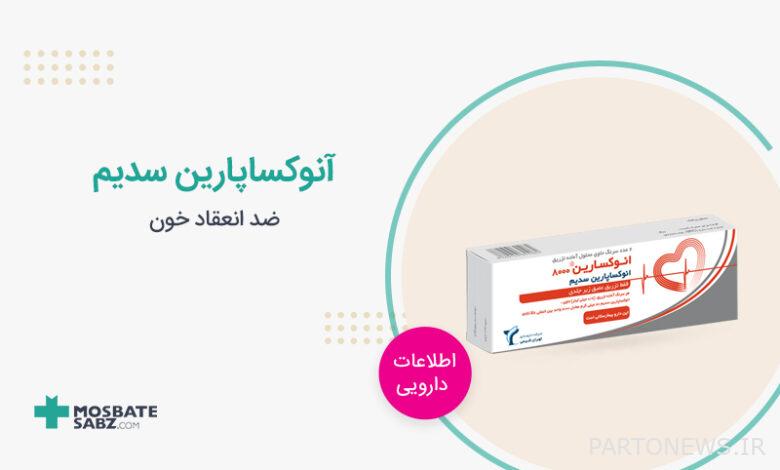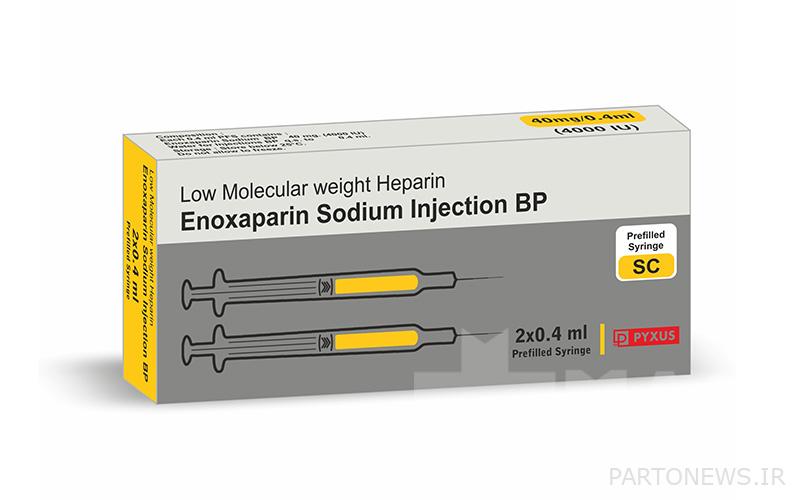What is Enoxaparin sodium for?

Enoxaparin sodium is an anticoagulant that works by inhibiting platelets. Platelets are cells that help blood clot, and this drug prevents the formation of blood clots by inhibiting platelets. This drug is prescribed by the doctor in various cases from the journal of prevention of blood clots in people with heart diseases, treatment of blood clots in the veins of the legs, prevention of blood clots after surgery, etc. In the following, we will review the mechanism of action, pharmaceutical forms, uses, method of use, precautions and contraindications of Enoxaparin sodium.
What we read in this article
Pharmaceutical forms of enoxaparin sodium
- Multi-dose vial: 100 mg/ml (3 ml vial)
- Pre-filled syringe: 30 mg / 0.3 ml, 40 mg / 0.4 ml, 60 mg / 0.6 ml, 80 mg / 0.8 ml, 100 mg / ml, 120 mg / 0.8 ml and 150 mg/ml
Enoxaparin sodium uses
Enoxaparin is used to prevent and treat harmful blood clots, which helps reduce the risk of stroke or heart attack. This drug helps maintain your blood flow by reducing the activity of clotting proteins in the blood. Enoxaparin is an anticoagulant, also known as a “blood thinner”. Conditions that increase the risk of blood clots include certain types of surgery (such as knee, hip, abdominal replacement), long periods of immobility, certain types of heart attack, and certain types of chest pain. Also, for some medical conditions, enoxaparin may be used in combination with other “blood thinners.”
- The biggest changes that will happen in WhatsApp this yearFebruary 3, 2024
- Applications for locating family and friends on AndroidFebruary 2, 2024
Uses of enoxaparin sodium in adults
- Deep vein thrombosis (prevention)
- Deep vein thrombosis (treatment)
- Unstable angina and non-Q-wave MI
- Acute coronary syndromes
Pharmacological effects and mechanism of action of Enoxaparin sodium
LMWH; Antithrombotic that inhibits factor Xa by increasing the rate of inhibition of clotting proteases activated by antithrombin III. The absorption of this drug with bioavailability is 92% in 12 hours (40 mg). Enoxaparin sodium is metabolized by the liver through desulfating or depolymerization to lower molecular weight species. It is also eliminated in a half-life of 4.5 hours (single dose based on activity) and excreted through urine.
Enoxaparin sodium dosage
Inject enoxaparin sodium under the skin as directed by your doctor, usually once or twice a day in the abdominal area (at least 2 inches from your belly button). The dose and length of treatment is based on the medical condition, response to treatment, and of course the patient’s age and weight. Before injecting each dose, clean the injection site with alcohol. Also, change the injection site each time to reduce damage under the skin. To minimize bruising, do not rub the injection site after the injection. Consult your doctor if any side effects occur.
Time to take enoxaparin sodium
- This medication is used for deep vein thrombosis (prevention) in patients at risk of undergoing abdominal surgery or hip or knee replacement surgery, as well as in patients who have limited mobility during acute illness. The dosage for abdominal surgery is 40 mg per day as a subcutaneous injection, and for knee or hip joint replacement surgery, it is 30 mg every 12 hours. Start treatment 12-24 hours after the operation; It is for 10 days or up to 35 days after the operation.
- Deep vein thrombosis (treatment) 1 mg/kg every 12 hours as a subcutaneous injection. The dosage for outpatient treatment (without hospitalization) is 1 mg/kg as a subcutaneous injection every 12 hours.
- This drug is used to prevent ischemic complications of unstable angina and myocardial infarction without Q wave when administered simultaneously with aspirin. The dosage is 1 mg/kg every 12 hours.
- Acute coronary syndromes dosage in non-enhancing myocardial infarction (NSTEMI), 1 mg/kg subcutaneously every 12 hours and myocardial infarction with enhancement (STEMI) All patients should be treated as soon as STEMI is diagnosed, 325-75 Take aspirin orally.
- The loading dose for people less than 75 years old is 30 mg intravenous bolus once plus 1 mg/kg as subcutaneous injection and the maintenance dose is 1 mg/kg every 12 hours. Also, for people over 75 years of age (without IV bolus), use 0.75 mg/kg as a subcutaneous injection every 12 hours and do not exceed 75 mg/dose for the first 2 doses.
- It should be noted that for women weighing less than 45 kg and men weighing less than 57 kg, increased exposure to preventive doses (without weight adjustment) has been observed. Monitor signs and symptoms of bleeding carefully.
Precautions
Before taking enoxaparin sodium, if you are allergic to it or heparin, avoid using the drug. This medicine may contain inactive ingredients that can cause allergic reactions or other problems. Talk to your doctor about your medical history, including artificial heart valve, kidney disease, liver disease, bleeding and blood problems (such as low platelet count), low platelet count after previous heparin treatment, stroke, high blood pressure, certain problems Ophthalmology (such as diabetic retinopathy), certain stomach and intestinal problems (such as active or recent ulcers), recent spinal surgery or puncture, spinal problems, etc.
- Epidural or spinal bleeding and subsequent hematomas have been reported with the use of enoxaparin and epidural or spinal anesthesia or analgesia and spinal puncture procedures, resulting in long-term or permanent paralysis.
- Use with caution in patients with hemorrhagic diathesis, uncontrolled arterial blood pressure or history of recent peptic ulcer, diabetic retinopathy, kidney dysfunction and bleeding.
- To minimize the risk of post-PCI bleeding, achieve hemostasis at the post-PCI puncture site. If using a closed device, the sheath can be removed immediately. If manual compression is used, remove the sheath 6 hours after the last dose of IV/SC enoxaparin. Additional doses are not recommended until 6-8 hours after capsule removal. Observe signs of bleeding and hematoma formation.
- monitor hyperkalemia (probably from aldosterone suppression); Mainly a concern among patients with risk factors, including renal dysfunction, is concomitant use of potassium-sparing diuretics or potassium supplements.
- Thrombocytopenia and thrombosis have been reported with enoxaparin. Use extreme caution or avoid in patients with a history of heparin-induced thrombocytopenia (HIT), especially if administered within 100 days of HIT. Monitor platelet count closely, if platelets are less than 100,000/mm³ or thrombosis occurs, discontinue therapy and consider alternative therapy.
- The use of therapy for thromboprophylaxis in pregnant women with mechanical prosthetic heart valves may lead to valve thrombosis.
- Heparin-induced thrombocytopenia with thrombosis (HITTS) may lead to limb infarction, limb ischemia, or death. Monitor closely for thrombocytopenia of any degree.
Enoxaparin sodium contraindications
- Active major bleeding, thrombocytopenia with antiplatelet antibody in the presence of enoxaparin or heparin
- History of heparin-induced thrombocytopenia (HIT) in the past 100 days or in the presence of circulating antibodies
- Hypersensitivity to enoxaparin, heparin, benzyl alcohol (multi-dose formulation only) or other ingredients
Enoxaparin sodium black box warnings
- Epidural or spinal hematomas may occur in patients anticoagulated with low molecular weight heparin (LMWH) or heparinoids receiving neuraxial (epidural and spinal) anesthesia or spinal puncture.
- These hematomas in some cases lead to long-term or permanent paralysis, and patients should be monitored frequently for signs and symptoms of neurological impairment (eg, tingling, numbness, muscle weakness).
- If a neurological disorder is observed, immediate treatment is necessary. Clinicians should consider the benefits versus the risks before neurologic intervention in patients who are anticoagulated or anticoagulated for thromboprophylaxis.
Appropriate timing of enoxaparin dosing in relation to catheter insertion or removal
- The optimal time between enoxaparin administration and neuraxial procedures is not known. Insertion or removal of a spinal catheter should be delayed for at least 12 hours after administration of prophylactic doses (eg, doses used to prevent DVT).
- Longer delays (24 hours) are appropriate for patients receiving higher therapeutic doses (eg, enoxaparin 1 mg/kg twice daily or 1.5 mg/kg daily).
- The postoperative dose of enoxaparin should not usually be given earlier than 4 hours after catheter removal. In all cases, the benefit-risk assessment must consider both the risk of thrombosis and the risk of bleeding in the context of the procedure and the patient’s risk factors.
Side effects of Enoxaparin sodium
Anemia, bleeding, heart failure, pain and swelling at the injection site, nausea, etc. are some of the side effects of enoxaparin sodium. If any of these effects persist or worsen, tell your doctor or pharmacist right away. This drug can cause bleeding if its effect on the clotting proteins in your blood is excessive. See a doctor if you notice serious symptoms of bleeding, including unusual pain, swelling and discomfort, unusual or prolonged bleeding, unusual or easy bruising, dark urine, black stools, severe headache, confusion, vision changes, unusual dizziness, etc.
- Bleeding
- Increased serum aminotransferases
- Fever
- Local site reactions
- Thrombocytopenia
- nausea
- Anemia
- ecchymosis
- Atrial fibrillation
- Heart failure
- pulmonary edema
- Pneumonia

Drug interactions of enoxaparin sodium
- Class X interactions (avoid): apixaban, dabigatran etexilate, edoxaban, hemin, mifepristone, omastaxin, rivaroxaban, urokinase, vorapaksar
- Enhancement of drug effects by enoxaparin: ibritomumab, thioxtan, nintedanib, obinotuzumab, omastaxin, palifermin, potassium salts, potassium-sparing diuretics, rivaroxaban, vitamin K antagonists, aliskiren, angiotensin II receptor blockers, angiotensin-converting enzyme inhibitors, collagenase (systemic), deferasirox, Deoxycholic acid
- Enhancement of enoxaparin effects by drugs: edoxaban, fatty emulsion (based on fish oil), Hemmin, herbs (with anticoagulant/antiplatelet properties), ibrutinib, inotresin, limaprost, mesoglycan, mifepristone, non-steroidal anti-inflammatory drugs, omega-3 fatty acid, Pentosan polysulfate sodium, pentoxifylline, prostacyclin analogs, aminosalicylic acid, acalabrutinib, drugs with anti-platelet properties, alemtozomb, antithrombin, apixaban, bromperidol, caplacizomb, dabigatran etexilate
Enoxaparin sodium consumption during pregnancy and breastfeeding
Human data from a retrospective cohort study suggest that enoxaparin does not increase the risk of major developmental abnormalities. Pregnancy alone increases the risk of thromboembolism, which is higher for women with thromboembolism and some high-risk pregnancy conditions. Pregnant women with thromboembolic disease, including those with mechanical prosthetic heart valves and those with inherited or acquired thrombophilia, are at risk for other maternal complications and fetal loss, regardless of the type of anticoagulant used.
All patients receiving anticoagulants, including pregnant women, are at risk of bleeding. Pregnant women receiving the drug should be monitored closely for evidence of bleeding or excessive anticoagulation. Bleeding can occur at any point and lead to the death of the mother or fetus. If the treatment is performed during pregnancy, pregnant women should be aware of possible risks for the fetus and the mother.
Effect of enoxaparin sodium on breastfeeding
No specific study or source is available regarding the effects of this drug on human milk. In lactating rats, the passage of enoxaparin or its metabolites into milk is very limited. The developmental and health benefits of breastfeeding should be considered along with the mother’s clinical need for treatment and any possible side effects on the breastfed child caused by medication or the mother’s underlying disease.
Enoxaparin sodium storage conditions
Enoxaparin sodium should be stored at room temperature and away from light and moisture. Do not store multidose vials for more than 28 days after first use. Dispose of this medicine properly when it has expired or is no longer needed.
The last word about the drug enoxaparin sodium
As we said in this article from Positive Green Pharmacy magazine, enoxaparin sodium is an anticoagulant drug that is used to prevent blood clotting. This drug is used to treat or prevent a wide range of medical conditions. Enoxaparin sodium is an effective medication, but like all medications, it can cause side effects, so it’s important to talk to your doctor before taking this medication to weigh the risks and benefits for your condition.
Site source: Medscape

